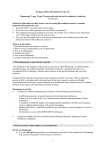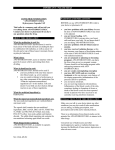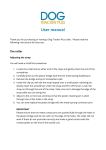Download PART III: CONSUMER INFORMATION
Transcript
IMPORTANT: PLEASE READ PART III: CONSUMER INFORMATION Pr HUMATROPE® Vials (somatropin for injection) pronounced HYOO-mah-trope This leaflet is for patients and caregivers. It is Part III of a three-part "Product Monograph" published when HUMATROPE was approved for sale in Canada. This leaflet is a summary and will not tell you everything about HUMATROPE. Contact your doctor or pharmacist if you have any questions about the drug. Please read this information carefully before you start to take your medicine, even if you have just refilled your prescription. Some of the information may have changed. Keep this pamphlet since you may need to refer to it after starting treatment with HUMATROPE. ABOUT THIS MEDICATION What the medication is used for: HUMATROPE is used to treat children and teenagers who are short or growing too slowly due to a medical condition such as growth hormone deficiency, Turner syndrome, idiopathic short stature, SHOX (short stature homeobox-containing gene) deficiency, or being born small for gestational age. HUMATROPE is also used in some adults who had growth hormone deficiency when they were children and still have growth hormone deficiency after they finish growing, or who do not make enough growth hormone as adults for some other reason. What it does: HUMATROPE is used to increase growth hormone levels. It stimulates bone growth in children unless the ends of the bones have hardened (closed epiphyses). In both adults and children with growth hormone deficiency, it also increases the growth of muscle and reduces body fat. When it should not be used: Treatment should not be started: • in children to promote growth when the ends of the long bones have hardened (closed epiphyses). Treatment should be stopped when adult height is reached. Reevaluation to find out whether the patient still has growth hormone deficiency will determine if continued treatment with HUMATROPE at a lower dose would be beneficial. • in patients with any evidence of an active cancer (either newly diagnosed or recurrent). • while patients have a serious illness following heart or abdominal surgery, or in patients who have just had a serious accident, or those with acute respiratory failure (low level of oxygen in the blood or high level of carbon dioxide in the blood). • in patients with Prader-Willi syndrome who are very obese or have severe breathing problems. There have HUMATROPE Product Monograph been reports of deaths in children with Prader-Willi syndrome who were treated with growth hormone and had one or more of the following risk factors: severe obesity, breathing problems, colds or lung infections. Treatment should not be started: • in patients known to be allergic to somatropin (the active substance in HUMATROPE), or to any of the ingredients in the powder or the diluent (listed below). • in patients who have undergone kidney transplant, until one year post-transplant. • in patients with diabetic retinopathy, a complication of diabetes that results from damage to the blood vessels of the light-sensitive tissue at the back of the eye (retina). What the medicinal ingredient is: Somatropin (recombinant human growth hormone) What the important nonmedicinal ingredients are: The HUMATROPE powder contains freeze-dried somatropin, dibasic sodium phosphate, glycine, and mannitol. The diluent (solution for dissolving somatropin) contains metacresol and glycerin. Phosphoric acid and/or sodium hydroxide may have been added at the time of manufacture to adjust the acidity of the liquid. What dosage forms it comes in: HUMATROPE is supplied as follows: Vial: 5 mg vial plus 5 mL diluent Cartridges: 6 mg, 12 mg, or 24 mg cartridges, each with 3.15 mL of diluent. HUMATROPE cartridges require the use of a HumatroPen to inject the drug. HumatroPens are supplied separately. WARNINGS AND PRECAUTIONS Serious Warnings and Precautions A doctor trained in hormone and growth disorders must examine the patient to decide if it is safe to use HUMATROPE. After the HUMATROPE powder has been dissolved it must be water-clear and free of particles. This medicine has been prescribed for you. Do not pass it on to others. It may harm them, even if their symptoms seem the same as yours. When medicine is injected into the same place over a long time, it can cause loss of fat tissue under the skin. It is therefore important to keep changing the injection site, and the doctor or nurse can tell you how. Before using HUMATROPE, the patient or caregiver should tell the doctor: • if the patient has an active brain tumour or any other tumour (either benign or cancerous). However, the Page 44 of 58 IMPORTANT: PLEASE READ • • • • • • • • • • • doctor may prescribe HUMATROPE if the patient has had a brain tumour and needs no more anti-tumour treatment for it. The patient should be re-examined frequently to make sure that the tumour has not come back or started to grow if the patient is a survivor of childhood cancer. if the patient is very ill after a serious operation, or after being treated for multiple injuries from an accident, or if the patient has sudden serious breathing problems. if the patient has diabetes (because more or less insulin may be needed when taking HUMATROPE). if a member of the patient’s family has diabetes. if the patient is taking a steroid medication (glucocorticoid) such as cortisone or prednisone. This is because the combination may reduce the success of the HUMATROPE treatment or because more of the steroid medication may be needed when the patient is also taking HUMATROPE. if the patient is taking a medication known to be metabolized by certain liver enzymes (e.g., cyclosporine, some anticonvulsants, and hormones such as estrogen and birth control pills). This is because the treatment with HUMATROPE may reduce the effectiveness of these drugs. if the patient, especially a child, develops abdominal pain. if the patient is or plans to become pregnant, or is breast-feeding. if the patient has hypothyroidism (low levels of thyroid hormone), because HUMATROPE may reduce the levels of thyroid hormone. The patient may require a change in dosage of his or her thyroid hormone medication. if the patient suffers from a bad headache or frequent headaches, or from problems with eyesight, vomiting or feeling sick. Very rarely, swelling of the brain may develop, and the doctor may want to examine the patient to look for signs of brain swelling. If this occurs it may be necessary to stop HUMATROPE treatment. if the patient develops a limp, or has hip or knee pain while being treated with HUMATROPE. If the patient is sensitive to any component of the diluent (the liquid used to mix with the HUMATROPE powder), Sterile Water for Injection, USP, may be used to dissolve the HUMATROPE supplied in vials (not cartridges). Refer to How to Store It section for storage instructions. If the patient has Turner syndrome and develops an ear infection or headaches her doctor should be told about these problems. If the patient is growth hormone-deficient and also has PraderWilli syndrome (a genetic disorder), the doctor should examine the patient for breathing problems and airway infections before starting HUMATROPE treatment, especially if the patient is overweight, has previously experienced severe breathing problems (especially during sleep), or suffered infection of the lungs or airways. If during treatment the patient has signs of breathing problems (snoring), treatment should be interrupted HUMATROPE Product Monograph and the cause assessed by the doctor. Treatment with HUMATROPE can change blood sugar levels. The doctor should check the patient’s blood sugar regularly while taking HUMATROPE, especially if there are risk factors for diabetes. Patients who have diabetes or impaired glucose tolerance should have their blood sugar closely monitored during HUMATROPE therapy. Leukemia has been reported in a small number of pediatric patients who have been treated with growth hormone, including growth hormone of pituitary origin, and man-made growth hormone products such as somatrem and somatropin. The relationship, if any, between leukemia and growth hormone is uncertain. Progression of pre-existing scoliosis (curvature of the spine) can occur in children who have rapid growth. HUMATROPE has not been shown to increase the occurrence of scoliosis. If the patient has hypopituitarism and is receiving standard hormone replacement therapy, the doctor should monitor the hormone replacement therapy closely during HUMATROPE treatment. If the patient has a growth disorder associated with being born small for gestational age, the blood sugar and insulin levels should be checked before starting treatment and regularly during treatment. Patients over 65 years of age may be more sensitive to HUMATROPE and may require lower dose of HUMATROPE. INTERACTIONS WITH THIS MEDICATION Tell the doctor if the patient is taking any of the following drugs: • Steroid medications such as glucocorticoids (e.g. cortisone or prednisone) • Medications known to be metabolized by certain liver enzymes (e.g., cyclosporine, some anticonvulsants, and hormones such as estrogen and birth control pills) • Insulin and anti-hyperglycemic agents Because HUMATROPE may affect how some hormones, such as cortisol and cortisone, are processed in the body, people may discover that they have an underactive adrenal gland after starting HUMATROPE therapy. In these cases, glucocorticoid replacement therapy would need to be started. If already on glucocorticoid therapy, dosage may need to be adjusted. PROPER USE OF THIS MEDICATION Be sure to change the injection site frequently to help prevent lipoatrophy (loss of fat tissue under the skin). In general, HUMATROPE should be injected in the evening or before bedtime. Page 45 of 58 IMPORTANT: PLEASE READ Usual dose: The doctor will instruct you on what is the best dose of HUMATROPE for you (or your child) based on individual needs. Use HUMATROPE exactly as the doctor tells you to. Reconstitution Instructions: Please refer to the enclosed reconstitution instructions. Overdose: Long-term overdosage or using HUMATROPE after the growth plates in the long bones have closed (hardened) may result in joint pain and continued growth of fingers, toes, nose, ears or jaw. If you think this is happening, tell the doctor. Overdose may change blood sugar levels, and patients may experience symptoms of hypoglycemia (low blood sugar), such as feeling shaky, dizzy and unwell or hyperglycemia (high blood sugar), such as increased urination or thirst. In case of drug overdose, contact a health care practitioner, hospital emergency department or regional Poison Control Centre immediately, even if there are no symptoms. Missed Dose: Contact your physician or pharmacist if you have missed a dose. SIDE EFFECTS AND WHAT TO DO ABOUT THEM Some people may be allergic to the diluent (liquid used to mix with the HUMATROPE powder). If there is any pain or redness at the injection site, or if there is any swelling, tell your doctor. Rarely, more severe allergic reactions may occur. Seek immediate medical help if you (or your child) experience any sudden trouble breathing, with swelling of the hands, feet or face. Children treated with HUMATROPE may have an increased risk of developing an inflammation of the pancreas called pancreatitis. If your child develops severe abdominal pain, contact your doctor. It is also important to have blood glucose checked if the patient has diabetes or a family history of diabetes. HUMATROPE may affect the way the body handles sugars from food and drink. The doctor may need to check the amount of sugar in the urine or blood. HUMATROPE can affect the amount of thyroid hormone in the blood, so patients must have thyroid function tests from time to time. If the thyroid is not working properly, HUMATROPE may not work as well as it should. Any child who begins to limp must be examined by a doctor. HUMATROPE may cause intracranial hypertension (increased pressure within the skull). Call the doctor if the patient has: a headache that doesn’t go away or is severe, or has headaches that become more frequent; problems with vision; nausea (feeling sick in the stomach) or vomiting. HUMATROPE Product Monograph Other possible side effects include headaches, muscle or joint pains (in hips or knees), swelling associated with tingling sensations in the hands, feeling weak, rarely high blood pressure, shortness of breath, and sleep apnea (pauses in breathing during sleep). If the headaches are bad or frequent, and accompanied by sickness or vision problems, tell the doctor immediately. For patients with Turner syndrome, HUMATROPE therapy may increase the already high frequency of ear infections. Your child should see her doctor if you think she has an ear infection. This is not a complete list of side effects. If any of the side effects gets serious, or if you notice any unexpected side effects while taking HUMATROPE, contact your doctor or healthcare professional. HOW TO STORE IT Before it has been reconstituted (mixed): Store HUMATROPE vial and diluent in the refrigerator at 2-8°C (36-46°F). After it has been reconstituted (mixed): When the vial is prepared with the supplied diluent, it may be stored in the refrigerator at 2-8°C (36-46°F) and MUST be used within 21 DAYS. Do NOT freeze. When the vial is prepared with Sterile Water for Injection, USP, it should be used immediately. Although not recommended, it may be stored in the refrigerator at 2-8°C (36-46°F), but must be used within 24 HOURS. Do NOT freeze. Keep out of reach of children. REPORTING SUSPECTED SIDE EFFECTS You can report any suspected adverse reactions associated with the use of health products to the Canada Vigilance Program by one of the following 3 ways: -------------------------------------------------------------------------• Report online at www.healthcanada.gc.ca/medeffect • Call toll-free at 1-866-234-2345 • Complete a Canada Vigilance Reporting Form and: - Fax toll-free to 1-866-678-6789, or - Mail to: Canada Vigilance Program Health Canada Postal Locator 0701D Ottawa, Ontario K1A 0K9 Postage paid labels, Canada Vigilance Reporting Form and the adverse reaction reporting guidelines are available on the MedEffect™ Canada website at www.healthcanada.gc.ca/medeffect. NOTE: Should you require information related to the management of side effects, contact your health care professional. The Canada Vigilance Program does not provide medical advice. MORE INFORMATION For more information, please contact your healthcare Page 46 of 58 IMPORTANT: PLEASE READ professional or pharmacist first, or Eli Lilly Canada Inc. at: 1-888-545-5972, or visit the website at: www.lilly.ca The information in this document is current as of the last revision date shown below. For the most current information please visit our website or contact us directly. HUMATROPE and HUMATROPEN are trademarks owned or licensed by Eli Lilly and Company, its subsidiaries or affiliates. This leaflet was prepared by Eli Lilly Canada Inc., Toronto, Ontario, M1N 2E8 Last Revised: August 19, 2013 HUMATROPE Product Monograph Page 47 of 58 IMPORTANT: PLEASE READ Reconstitution Instructions for Pr HUMATROPE® Vials Do not mix (reconstitute) the drug or inject it until you have been thoroughly trained in the proper techniques by your doctor. Use sterile techniques as instructed by your doctor. Discard syringes and/or needles after each use. When the vial has been prepared with the supplied diluent, it may be stored in the refrigerator at 2 - 8°C (36 46°F) and MUST be used within 21 DAYS. Do NOT freeze. Reconstituting the Vial of HUMATROPE Reconstitute HUMATROPE only with Diluent for HUMATROPE. Do not use other solutions for reconstitution unless instructed to do so by your doctor. Your doctor will also tell you what size syringe and needle to use and how much diluent to add to the vial of HUMATROPE. Always start by washing your hands. 1. Remove and discard plastic caps from tops of vials of diluent and HUMATROPE. Wipe tops of both vials with an alcohol swab (Figure 1). Remove needle cover and save. Pull back on syringe plunger to draw up an amount of air equal to the amount of diluent your doctor has prescribed. Insert needle in stopper of diluent vial, and inject air into vial. 2. Hold vial upside down and, making sure needle tip remains in solution, withdraw the amount of diluent your doctor has prescribed (Figure 2). After making sure that no air bubbles are in the syringe, turn vial upright and, holding barrel, remove syringe. HUMATROPE Product Monograph Page 48 of 58 IMPORTANT: PLEASE READ 3. Insert same needle into vial of HUMATROPE and gently aim needle tip toward wall of vial. Slowly inject the diluent by aiming the stream of liquid against the wall of vial (Figure 3). Do not aim it at the white powder at the bottom of the vial. To equalize the pressure, withdraw a volume of air equal to the amount of diluent added before removing the syringe from the vial. If the needle can be removed from the barrel of the syringe remove and discard the needle. If the needle and syringe are made as 1 unit, discard the entire unit. 4. Swirl the vial with a gentle rotary motion until contents are completely dissolved (Figure 4). Do not shake. Preparing the Injection 1. Do not use reconstituted HUMATROPE if it is cloudy or contains particles. 2. If the needle can be removed from the type of syringe you are using, a new needle should be placed on the syringe before the injection. If the syringe and needle are made as 1 unit, another unit should be used for the injection. 3. Before and after injection, the rubber stopper of the vial should be wiped with rubbing alcohol or an alcoholic antiseptic solution to prevent contamination of the contents by repeated needle insertions. 4. Remove the needle cover and draw an amount of air into the syringe equal to your dose of HUMATROPE. 5. Insert needle into vial of reconstituted HUMATROPE and inject the air into the vial. Turn the vial upside down, and, making sure needle tip is in solution, withdraw your correct dose (see Figure 2). Make sure that no air bubbles are in the syringe. 6. Remove syringe and replace needle cover. Write date of reconstitution on vial label, and discard unused diluent. 7. Return unused portion of reconstituted HUMATROPE to refrigerator and use within 21 days. 8. Dispose of needle or the needle and syringe after use. Injecting HUMATROPE 1. Gently tap injection site several times with fingers. 2. Wipe the area thoroughly with an alcohol swab. Use a circular motion and work outward from the inside of the circle. 3. Subcutaneous Injection: With the thumb and forefinger, stabilize the skin by spreading or pinching up a large area of skin. HUMATROPE Product Monograph Page 49 of 58 IMPORTANT: PLEASE READ • Holding the syringe at a 90-degree angle to injection site, quickly insert the needle all the way into the skin. • Slowly inject the solution. • Remove the needle quickly, and apply pressure over the injection site with a dry gauze pad or cotton ball. Rub for several seconds. • Dispose of needle or the needle and syringe after use. 4. Intramuscular Injection: With the thumb and first 2 fingers, press the skin down firmly against a large muscle mass, such as the thigh. • Holding the syringe at a 90-degree angle to injection site, quickly insert the needle all the way into the skin. • When the needle is in place, slowly pull back on the plunger. If blood enters the syringe, remove needle, discard syringe and drug, and prepare another injection. • If no blood enters the syringe, slowly inject the solution. • Dispose of needle or the needle and syringe after use as per your doctor’s instructions. For more information, please contact your healthcare professional or pharmacist first, or Eli Lilly Canada Inc. at: 1-888-545-5972 or visit the website at www.lilly.ca The information in this document is current as of the last revision date shown below. For the most current information please visit our website or contact us directly. HUMATROPE is a trademark owned or licensed by Eli Lilly and Company, its subsidiaries or affiliates. This leaflet was prepared by Eli Lilly Canada Inc., Toronto, Ontario, M1N 2E8. Last revised: August 19, 2013 HUMATROPE Product Monograph Page 50 of 58 IMPORTANT: PLEASE READ PART III: CONSUMER INFORMATION Pr HUMATROPE® Cartridges (somatropin for injection) pronounced HYOO-mah-trope This leaflet is for patients and caregivers. It is Part III of a three-part "Product Monograph" published when HUMATROPE was approved for sale in Canada. This leaflet is a summary and will not tell you everything about HUMATROPE. Contact your doctor or pharmacist if you have any questions about the drug. Please read this information carefully before you start to take your medicine, even if you have just refilled your prescription. Some of the information may have changed. Keep this pamphlet since you may need to refer to it after starting treatment with HUMATROPE. ABOUT THIS MEDICATION What the medication is used for: HUMATROPE is used to treat children and teenagers who are short or growing too slowly due to a medical condition such as growth hormone deficiency, Turner syndrome, idiopathic short stature, SHOX (short stature homeobox-containing gene) deficiency, or being born small for gestational age. HUMATROPE is also used in some adults who had growth hormone deficiency when they were children and still have growth hormone deficiency after they finish growing, or who do not make enough growth hormone as adults for some other reason. What it does: HUMATROPE is used to increase growth hormone levels. It stimulates bone growth in children unless the ends of the bones have hardened (closed epiphyses). In both adults and children with growth hormone deficiency, it also increases the growth of muscle and reduces body fat. When it should not be used: Treatment should not be started: • in children to promote growth when the ends of the long bones have hardened (closed epiphyses). Treatment should be stopped when adult height is reached. Reevaluation to find out whether the patient still has growth hormone deficiency will determine if continued treatment with HUMATROPE at a lower dose would be beneficial. • in patients with any evidence of an active cancer (either newly diagnosed or recurrent). • while patients have a serious illness following heart or abdominal surgery, or in patients who have just had a serious accident, or those with acute respiratory failure (low level of oxygen in the blood or high level of carbon dioxide in the blood). • in patients with Prader-Willi syndrome who are very obese or have severe breathing problems. There have been reports of deaths in children with Prader-Willi HUMATROPE Product Monograph syndrome who were treated with growth hormone and had one or more of the following risk factors: severe obesity, breathing problems, colds or lung infections. Treatment should not be started: • in patients known to be allergic to somatropin (the active substance in HUMATROPE), or to any of the ingredients in the powder or the diluent (listed below). • in patients who have undergone kidney transplant, until one year post-transplant. • in patients with diabetic retinopathy, a complication of diabetes that results from damage to the blood vessels of the light-sensitive tissue at the back of the eye (retina). What the medicinal ingredient is: Somatropin (recombinant human growth hormone) What the important nonmedicinal ingredients are: The HUMATROPE powder contains freeze-dried somatropin, dibasic sodium phosphate, glycine, and mannitol. The diluent (solution for dissolving somatropin) contains metacresol and glycerin. Phosphoric acid and/or sodium hydroxide may have been added at the time of manufacture to adjust the acidity of the liquid. What dosage forms it comes in: HUMATROPE is supplied as follows: Vial: 5 mg vial plus 5 mL diluent Cartridges: 6 mg, 12 mg, or 24 mg cartridges, each with 3.15 mL of diluent. HUMATROPE cartridges require the use of a HumatroPen to inject the drug. HumatroPens are supplied separately. WARNINGS AND PRECAUTIONS Serious Warnings and Precautions A doctor trained in hormone and growth disorders must examine the patient to decide if it is safe to use HUMATROPE. After the HUMATROPE powder has been dissolved it must be water-clear and free of particles. This medicine has been prescribed for you. Do not pass it on to others. It may harm them, even if their symptoms seem the same as yours. When medicine is injected into the same place over a long time, it can cause loss of fat tissue under the skin. It is therefore important to keep changing the injection site, and the doctor or nurse can tell you how. Before using HUMATROPE, the patient or caregiver should tell the doctor: • if the patient has an active brain tumour or any other tumour (either benign or cancerous). However, the doctor may prescribe HUMATROPE if the patient has Page 51 of 58 IMPORTANT: PLEASE READ • • • • • • • • • • • had a brain tumour and needs no more anti-tumour treatment for it. The patient should be re-examined frequently to make sure that the tumour has not come back or started to grow if the patient is a survivor of childhood cancer. if the patient is very ill after a serious operation, or after being treated for multiple injuries from an accident, or if the patient has sudden serious breathing problems. if the patient has diabetes (because more or less insulin may be needed when taking HUMATROPE). if a member of the patient’s family has diabetes. if the patient is taking a steroid medication (glucocorticoid) such as cortisone or prednisone. This is because the combination may reduce the success of the HUMATROPE treatment or because more of the steroid medication may be needed when the patient is also taking HUMATROPE. if the patient is taking a medication known to be metabolized by certain liver enzymes (e.g., cyclosporine, some anticonvulsants, and hormones such as estrogen and birth control pills). This is because the treatment with HUMATROPE may reduce the effectiveness of these drugs. if the patient, especially a child, develops abdominal pain. if the patient is or plans to become pregnant, or is breast-feeding. if the patient has hypothyroidism (low levels of thyroid hormone), because HUMATROPE may reduce the levels of thyroid hormone. The patient may require a change in dosage of his or her thyroid hormone medication. if the patient suffers from a bad headache or frequent headaches, or from problems with eyesight, vomiting or feeling sick. Very rarely, swelling of the brain may develop, and the doctor may want to examine the patient to look for signs of brain swelling. If this occurs it may be necessary to stop HUMATROPE treatment. if the patient develops a limp, or has hip or knee pain while being treated with HUMATROPE. If the patient is sensitive to any component of the diluent (the liquid used to mix with the HUMATROPE powder), Sterile Water for Injection, USP, may be used to dissolve the HUMATROPE supplied in vials (not cartridges). Refer to How to Store It section for storage instructions. If the patient has Turner syndrome and develops an ear infection or headaches her doctor should be told about these problems. If the patient is growth hormone-deficient and also has PraderWilli syndrome (a genetic disorder), the doctor should examine the patient for breathing problems and airway infections before starting HUMATROPE treatment, especially if the patient is overweight, has previously experienced severe breathing problems (especially during sleep), or suffered infection of the lungs or airways. If during treatment the patient has signs of breathing problems (snoring), treatment should be interrupted and the cause assessed by the doctor. HUMATROPE Product Monograph Treatment with HUMATROPE can change blood sugar levels. The doctor should check the patient’s blood sugar regularly while taking HUMATROPE, especially if there are risk factors for diabetes. Patients who have diabetes or impaired glucose tolerance should have their blood sugar closely monitored during HUMATROPE therapy. Leukemia has been reported in a small number of pediatric patients who have been treated with growth hormone, including growth hormone of pituitary origin, and man-made growth hormone products such as somatrem and somatropin. The relationship, if any, between leukemia and growth hormone is uncertain. Progression of pre-existing scoliosis (curvature of the spine) can occur in children who have rapid growth. HUMATROPE has not been shown to increase the occurrence of scoliosis. If the patient has hypopituitarism and is receiving standard hormone replacement therapy, the doctor should monitor the hormone replacement therapy closely during HUMATROPE treatment. If the patient has a growth disorder associated with being born small for gestational age, the blood sugar and insulin levels should be checked before starting treatment and regularly during treatment. Patients over 65 years of age may be more sensitive to HUMATROPE and may require lower dose of HUMATROPE. INTERACTIONS WITH THIS MEDICATION Tell the doctor if the patient is taking any of the following drugs: • Steroid medications such as glucocorticoids (e.g. cortisone or prednisone) • Medications known to be metabolized by certain liver enzymes (e.g., cyclosporine, some anticonvulsants, and hormones such as estrogen and birth control pills) • Insulin and anti-hyperglycemic agents Because HUMATROPE may affect how some hormones, such as cortisol and cortisone, are processed in the body, people may discover that they have an underactive adrenal gland after starting HUMATROPE therapy. In these cases, glucocorticoid replacement therapy would need to be started. If already on glucocorticoid therapy, dosage may need to be adjusted. PROPER USE OF THIS MEDICATION Be sure to change the injection site frequently to help prevent lipoatrophy (loss of fat tissue under the skin). In general, HUMATROPE should be injected in the evening or before bedtime. Page 52 of 58 IMPORTANT: PLEASE READ Usual dose: The doctor will instruct you on what is the best dose of HUMATROPE for you (or your child) based on individual needs. Use HUMATROPE exactly as the doctor tells you to. Reconstitution Instructions: Please refer to the enclosed reconstitution instructions. Overdose: Long-term overdosage or using HUMATROPE after the growth plates in the long bones have closed (hardened) may result in joint pain and continued growth of fingers, toes, nose, ears or jaw. If you think this is happening, tell the doctor. Overdose may change blood sugar levels, and patients may experience symptoms of hypoglycemia (low blood sugar), such as feeling shaky, dizzy and unwell or hyperglycemia (high blood sugar), such as increased urination or thirst. In case of drug overdose, contact a health care practitioner, hospital emergency department or regional Poison Control Centre immediately, even if there are no symptoms. Missed Dose: Contact your physician or pharmacist if you have missed a dose. SIDE EFFECTS AND WHAT TO DO ABOUT THEM Some people may be allergic to the diluent (liquid used to mix with the HUMATROPE powder). If there is any pain or redness at the injection site, or if there is any swelling, tell your doctor. Rarely, more severe allergic reactions may occur. Seek immediate medical help if you (or your child) experience any sudden trouble breathing, with swelling of the hands, feet or face. Children treated with HUMATROPE may have an increased risk of developing an inflammation of the pancreas called pancreatitis. If your child develops severe abdominal pain, contact your doctor. It is also important to have blood glucose checked if the patient has diabetes or a family history of diabetes. HUMATROPE may affect the way the body handles sugars from food and drink. The doctor may need to check the amount of sugar in the urine or blood. Other possible side effects include headaches, muscle or joint pains (in hips or knees), swelling associated with tingling sensations in the hands, feeling weak, rarely high blood pressure, shortness of breath, and sleep apnea (pauses in breathing during sleep). If the headaches are bad or frequent, and accompanied by sickness or vision problems, tell the doctor immediately. For patients with Turner syndrome, HUMATROPE therapy may increase the already high frequency of ear infections. Your child should see her doctor if you think she has an ear infection. This is not a complete list of side effects. If any of the side effects gets serious, or if you notice any unexpected side effects while taking HUMATROPE, contact your doctor or healthcare professional. HOW TO STORE IT Before it has been reconstituted (mixed): Store HUMATROPE cartridges and diluent in the refrigerator at 2-8°C (36-46°F). After it has been reconstituted (mixed): When the cartridge is prepared with the supplied diluent, it may be stored in the refrigerator at 2-8°C (36-46°F) and MUST be used within 28 DAYS. Do NOT freeze. Keep out of reach of children. REPORTING SUSPECTED SIDE EFFECTS You can report any suspected adverse reactions associated with the use of health products to the Canada Vigilance Program by one of the following 3 ways: -------------------------------------------------------------------------• Report online at www.healthcanada.gc.ca/medeffect • Call toll-free at 1-866-234-2345 • Complete a Canada Vigilance Reporting Form and: - Fax toll-free to 1-866-678-6789, or - Mail to: Canada Vigilance Program Health Canada Postal Locator 0701D Ottawa, Ontario K1A 0K9 Postage paid labels, Canada Vigilance Reporting Form and the adverse reaction reporting guidelines are available on the MedEffect™ Canada website at www.healthcanada.gc.ca/medeffect. HUMATROPE can affect the amount of thyroid hormone in the blood, so patients must have thyroid function tests from time to time. If the thyroid is not working properly, HUMATROPE may not work as well as it should. NOTE: Should you require information related to the management of side effects, contact your health care professional. The Canada Vigilance Program does not provide medical advice. Any child who begins to limp must be examined by a doctor. MORE INFORMATION HUMATROPE may cause intracranial hypertension (increased pressure within the skull). Call the doctor if the patient has: a headache that doesn’t go away or is severe, or has headaches that become more frequent; problems with vision; nausea (feeling sick in the stomach) or vomiting. HUMATROPE Product Monograph For more information, please contact your healthcare professional or pharmacist first, or Eli Lilly Canada Inc. at: 1-888-545-5972, or visit the website at: www.lilly.ca The information in this document is current as of the last revision date shown below. For the most current information Page 53 of 58 IMPORTANT: PLEASE READ please visit our website or contact us directly. HUMATROPE and HUMATROPEN are trademarks owned or licensed by Eli Lilly and Company, its subsidiaries or affiliates. This leaflet was prepared by Eli Lilly Canada Inc., Toronto, Ontario, M1N 2E8 Last Revised: August 19, 2013 HUMATROPE Product Monograph Page 54 of 58 Reconstitution Instructions for PrHUMATROPE® Cartridges __ HUMATROPE Product Monograph Page 55 of 58 Preparing Your New Cartridge Remove ALL contents from the tray. Note: This product is designed for left or right handed use. Please feel free to use whichever hand is most comfortable for you. HUMATROPE Product Monograph Grasp Needle Cover, which is at the bottom of the Diluent Syringe. Remove Needle Cover and discard. DO NOT depress Plunger yet. It is okay if a drop of fluid is lost. It is not necessary to release air from the Diluent Syringe. Hold cartridge, Black Triangles towards the Diluent Syringe. Align the cartridge and Diluent Syringe in a straight line. DO NOT insert the cartridge at an angle. PUSH the cartridge STRAIGHT in until it stops AND the Black Triangles ARE COVERED. You may hear or feel a click. DO NOT twist the cartridge. Page 56 of 58 Hold the Diluent Syringe and the cartridge together with TWO HANDS. Push and release the Plunger 2 or 3 times until the Diluent is in the cartridge. HUMATROPE Product Monograph Remove thumb from the Plunger and check that the Diluent Syringe is empty (it is normal for small drops of Diluent to remain in the Diluent Syringe). With thumb OFF the plunger, pull the cartridge away from the Diluent Syringe. Place the End Cap on a hard, flat surface. Push the Diluent Syringe onto the End Cap and immediately discard the Diluent Syringe as instructed by your healthcare professional. Page 57 of 58 For more information, please contact your healthcare professional or pharmacist first, or Eli Lilly Canada Inc. at: 1-888-545-5972 or visit the website at www.lilly.ca The information in this document is current as of the last revision date shown below. For the most current information please visit our website or contact us directly. HUMATROPE and HUMATROPEN are trademarks owned or licensed by Eli Lilly and Company, its subsidiaries or affiliates. This leaflet was prepared by Eli Lilly Canada Inc., Toronto, Ontario, M1N 2E8. Last revised: August 19, 2013 Mix the cartridge by gently inverting10 times and let sit for 3 minutes, DO NOT SHAKE. Inspect the solution. The HUMATROPE solution should be clear . If the solution is clear, your cartridge is now prepared and ready to be attached to your HUMATROPEN (see the User Manual for your HUMATROPEN). After the cartridge has been reconstituted (mixed): with the supplied diluent, it may be stored in the refrigerator at 2-8°C (36-46°F) and MUST be used within 28 DAYS. Do NOT freeze If the solution is cloudy or contains particles, gently invert the cartridge 10 additional times. Let the cartridge sit for 5 more minutes. If the solution remains cloudy or contains particles, DO NOT USE THE CARTRIDGE. HUMATROPE Product Monograph Page 58 of 58

















![[Product Monograph Template - Standard]](http://vs1.manualzilla.com/store/data/005786637_1-bbde87d0b5b85ef8c8ff6a7fd943fd08-150x150.png)


















